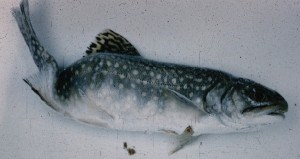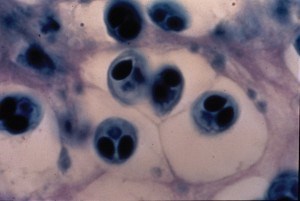
ItÔÇÖs like a scene from Star Wars, but this battle is waged in the cool waters of lakes and streams. The alien craft looks like a three-legged squid, armed with grappling hook-like filaments that can be fired at their prey ÔÇöyoung salmon or troutÔÇösecuring the parasite to the fish skin. These are TAMS, a mature form of the spores that cause whirling disease (Myxobolus cerabralis). TheyÔÇÖve just come from their gestation in the bottom-dwelling tubifex worm, and are now ready to inject the next generation of spores into the muscle of the fish.
Hungry for the cartilage on which they feed, the new spores make their way through the fish body, causing spinal deformities, a blackened tail and possibly the telltale swimming in circlesÔÇô or whirlingÔÇôthat the disease is named for. Death comes early, at which point the infectious spores leave the fish body, seeking fresh tubifex worms in which they can develop into the alien-like TAMS and begin the cycle again.

For the first time ever, this past August whirling disease was found in Canada, in Johnson Lake, Banff National Park. ItÔÇÖs bad news. If the parasite takes hold, it can cause massive declines in juvenile fish, though the impact tends to vary by location. The whirling disease outbreak in the Madison River, Montana in the 1990s caused juvenile trout populations to decline by 90 percent, though they have since recovered.
Whirling disease spreads in a number of ways. The movement of live, infected fish from one water body to another is a common form of transmission, and this can happen naturally, through illegal fish stocking, and even by birds that accidentally drop their meal in a new body of water en route to dinner. The disease can also travel on watercraft, boat trailers, clothing, boots and buckets if not cleaned properly.
Just how far afield has the disease travelled in the Canadian Rockies? Parks Canada is still in the delineation and detection stage, said Bill Hunt, Resource Conservation Manager for Banff National Park. Since the Johnson Lake detection, Parks Canada has found the parasite between Bow Falls and the Banff National Park East Boundary. As of last week, further detections were confirmed in the Spray River, Cascade Creek, Carrot Creek, the Lower Cascade River and another in the Bow. Parks Canada is continuing to test in the middle and Upper Bow River, and testing is also underway in Jasper National Park.

Testing will occur at three sites in Jasper, said Hunt. The Upper Sunwapta River was chosen as it is the spot closest to the Banff detections, and is home to Brook Trout, a possible host. The Mid-Maligne River was chosen as it experiences heavier recreational boating and is home to rainbow and brook trout. The Pocahontas Pond Outflow Creek was chosen because it is home to both brook and rainbow trout, and is closest to the Eastern Boundary of Jasper National Park. With so many samples to process, it may be several weeks before results are available.
While a serious problem for all salmon and trout species, the disease is especially concerning for fish species already at risk. The Western Cutthroat Trout is an example of a federally protected species vulnerable to whirling disease. Depending on the outcome of the detection research, Hunt said the presence of the parasite may change the requirement for critical habitat protection in Banff under the Species at Risk Act.

ÔÇťThere may be some high alpine lakes within their native range that originally did not qualify as core habitat, but may now be important because they are isolated,ÔÇŁ he said.
Though a serious concern for fish, Hunt was quick to point out that whirling disease does not affect mammals. It wonÔÇÖt make your pet, or you, sick. However, people can help prevent its spread by visiting Parks CanadaÔÇÖs website to learn how to decontaminate equipment, and by reporting fish that have blackened tails, are whirling, or otherwise unhealthy. LetÔÇÖs keep it out of Jasper National Park, if we can.
Niki Wilson
Special to the 51░Á═°
